RIGUARDA LE REGATE

RACE PROGRAM
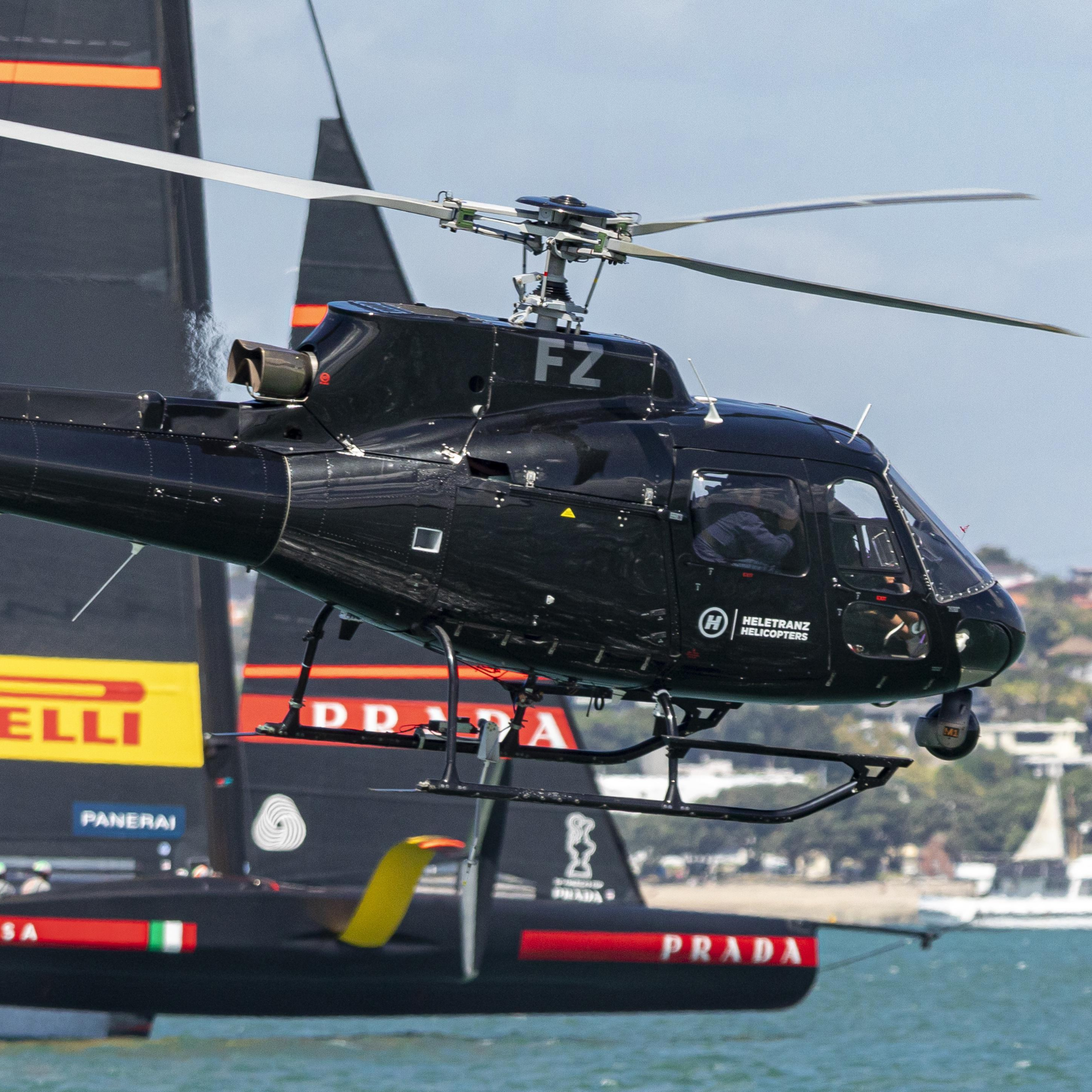
WATCH ON TV
Watch the race live on TV to share the thrill and the adrenaline of the regatta with the Luna Rossa Prada Pirelli team.
In Italy all races (including the Preliminary Regattas) will be broadcast live on Mediaset Channel 20 and on Sky's dedicated channels (Sky Sport Arena 204 & Sky Sport 200).
Don’t miss a single minute of your favourite team's challenge: featuring expert commentators and with graphics and animation directly from the racecourse, following Luna Rossa’s regattas will be even more exciting .

WATCH ONLINE
Watch the race on your device and don’t miss the action on the racecourse and onboard Luna Rossa.
View the Preliminary Regattas, the Youth and the Puig Women’s events and the 37th America’s Cup directly from your devices.
Each regatta will be broadcast free on air on the www.lunarossachallenge.com website and on Facebook.
Graphics and animation from the racecourse, onboard cameras and stories from the main players will take you to the heart of the action both on the AC40 One Design and on the flying AC75 monohulls, for one of the most exciting sporting and technology challenges ever seen.

Follow our social media for constant updates from the racecourse.
Follow the racing on our social media and don’t miss a minute of the action.
Stay connected and updated. All the news in real time, directly from the racecourse.
37th AMERICA'S CUP: The Timeline

Preliminary Race #1
September 14 - 17, 2023 (Vilanova i la Geltrú, Spain)
Preliminary Race #2
November 28 - December 2, 2023 (Jeddah, Saudi Arabia)
Preliminary Race #3
August 22 - 25, 2024 (Barcelona, Spain)

Official Opening 37th America’s Cup
August 22, 2024 (Barcelona, Spain)
UniCredit Youth America’s Cup
September 17 - 26, 2024 (Barcelona, Spain)
Louis Vuitton Cup
August 29 - October 5, 2024 (Barcelona, Spain)
PUIG Women’s America’s Cup
October 5 - 13, 2024 (Barcelona, Spain)
Louis Vuitton 37th America's Cup
October 12 - 21, 2024 (Barcelona, Spain)


- THE RACING SPOT
- FORMULA 1 ®
- GRAN TURISMO
- OTHER STORIES
- EMOTIONS & NUMBERS
- HOT OFF THE TRACK
- RACING PODCAST
- RACING NEWS
Luna Rossa, the wind gives the power

It is easy to find things in common between a car and a motor boat. It is less simple when the boat is a sailing yacht: the hull (or the hulls, in the case of a catamaran or a trimaran) corresponds to the chassis and the set of sails - including the mast - matches the propeller. However, there's a huge difference compared to an engine, whether combustion or electric: the ‘fuel' is not available from a station and above all, even when it is available, it needs to be managed. Wind, even in areas considered as being reliable, changes in both intensity and direction. And this according to a logic that yachtsmen can sometimes predict, based on personal experience and increasingly sophisticated instrumentation. But sometimes, even the most skilled of them get it wrong, even spectacularly. And there is nothing more frustrating for a regatta racer waiting to make the best of the wind ‘power' than to remain without any.
The two forces
Accordingly, in order to understand the importance of wind on the boat's motion, it is important to clarify the relationship between aerodynamic force and hydrodynamic force. In a situation of zero wind that gradually increases, a stationary sailing boat – with the mainsail hoisted – starts to move and shifts laterally due to the effect of the aerodynamic force. The displacement of the hull immersed in the water in turn generates a hydrodynamic force. The result of the two forces combined is a new force - known as a headwind force - directed at the bow of the boat. The boat accelerates until the two forces become equal and opposite, at which point the speed becomes constant. As the wind drops, deceleration occurs, just like acceleration can occur if the wind picks up, keeping in mind that too much power is likely to cause trouble. The task of the ballast under the keel, which is a characteristic of traditional boats, is to prevent capsizing when close hauled – the point of sail into the wind – the wind ‘pushes' too laterally on the sails and without a weight that contrasts its force, the hull tilts dangerously.
The battle of sails
The sails therefore have the task of ‘collecting' the wind to the correct extent to seek the best performance possible, a feat which however also requires two other factors: the hydrodynamic quality of the hull and the capabilities of the crew. So now we can link this to the concept of motorsports: only a mix between chassis, engine and driver can lead to success: just two of these are hardly enough, and very rarely is one alone. Consequently, it is quite understandable how the design of the ‘rigging and sails' has been vital since the very onset of yachting. As is the fact that the America's Cup constitutes the main lab to test all technical progress: for a hundred years, it was the American title holders who launched just the right new features at just the right time, something that their rivals were often not permitted to do. But since the triumph of the Australia 3 – in Newport, in 1983 – many challengers have also been able to astound when it comes to sails. The positive aspect of the experiment was the subsequent adaptation of the new features on normal boats, just like what happens in car races, starting with F1. Materials such as kevlar, mylar, carbon fibre – now commonplace – were introduced for the America's Cup.
Now there's the soft wing
The AC 75 – the America's Cup class – has one more feature which on the one hand enhances, and on the other makes things a little trickier. These are the foils: the foil cant arms that rest on the water to provide the necessary stability. On the sides of the course, the leeward foil provides the lifting thrust for the boat, while the windward foil provides the straightening momentum (since there is a bulb missing under the keel to act as a ballast) and prevents capsizing – except in the event of errors or forcing. Furthermore, the boat has a soft wing, which consists of a twin-skin mainsail. The double-sail skins combine with the spar to form a wing. The soft wing generates the same efficiency as a rigid wing – resisting to wind power more – but with an ease of use similar to that of a traditional sail. It is a highly sophisticated contraption: 20,000 km of carbon wires are used to make it, while another 5,000 are needed to weave each jib and 12,000 for each Code Zero, the sail for running downwind. The power of Aeolus, the god of wind, is not easy to master, but in the America's Cup, they know how to handle it.
Related Stories

WANT TO KNOW MORE Ok
SUBSCRIBE HERE
Thanks for your subscription.
- AROUND THE SAILING WORLD
- BOAT OF THE YEAR
- Email Newsletters
- Best Marine Electronics & Technology
- America’s Cup
- St. Petersburg
- Caribbean Championship
- Boating Safety

Luna Rossa Challenge Withdraws from 35th America’s Cup
- By Lisa Gabrielson
- Updated: April 2, 2015
In a statement on its official webpage , Team Luna Rossa has announced their withdrawal from the 35th America’s Cup. This follows yesterday’s vote by the participating teams to introduce a new class for AC35—a wing-sailed, foiling catamaran between 45 and 50 feet. The rule changes were passed by a majority vote of the Competitor Forum, comprising the six teams that were, at the time, entered in the America’s Cup (Emirates Team New Zealand, Oracle Team USA, Team France, Luna Rossa Challenge, Artemis Racing, and Ben Ainsle Racing). An updated Protocol and a new Class Rule is set to be published this week.
The full statement from Luna Rossa Challenge:
“The result of the vote proposed by the Event Authority with the agreement of the Defender of the 35th America’s Cup has overturned, with a majority vote, the America’s Cup Class Rule for the boat with which this edition will be held; this happened notwithstanding the fact that such rule had been previously adopted unanimously by the teams and was in force since June 2014.
Following a careful evaluation of the serious implications of this unprecedented initiative, Team Luna Rossa confirms that it will withdraw from the 35th America’s Cup.
Team Luna Rossa indeed considers illegitimate the procedure adopted and founded on an evident abuse of process by surreptitious use of procedures to modify the Protocol in order to overturn the Class Rule, which instead requires the unanimity of the teams entered.
This is an attempt to introduce boats that are substantially monotypes and in total contrast with the ultra-centennial tradition of the America’s Cup, not to mention a two-month extension period to introduce further modifications to the rules, decided by the majority.
All of the above contributes to a lack of credibility and uncertain technical grounds for what should instead be the most sophisticated sailing competition in the world.
This radical change also implies a waste of important resources already invested based on the rules that were sanctioned in June last year. This means that the claim to reduce costs reveals itself as a pure pretext aimed to annihilate research and development achievements of some teams, and to favor instead preconceived technical and sporting positions by means of changing the most important element in the competition, the boat.
As a confirmation of this, it is important to underline the fact that Luna Rossa frequently advanced proposals aimed at containing costs that however would not have changed the nature of the boats, but these proposals have systematically been rejected by the Defender.
Team Luna Rossa has also taken into consideration the possibility to protest through the Arbitration Panel as foreseen by the Protocol; it has however noted that, ten months after signing the Protocol, the Defender is only now initiating the first formal procedures to compose this important body. This fact contributes to making the entire governance of the Event even less credible and reliable.
Team Luna Rossa regrets the repercussions that this difficult decision will have on the members of the Team —although it will honor all of its contractual obligations —and on the sailing event planned to take place in Cagliari next June and obviously understands the disappointment of the many fans who have supported Luna Rossa during the last four editions of the America’s Cup.
Patrizio Bertelli declared: “I want to thank the whole team for its hard work during this past year; regretfully this effort has been frustrated by this maneuver that is unprecedented in the history of the America’s Cup.
However, in sports, as in life, one cannot always go for compromise, after compromise, after compromise; sometimes it is necessary to make decisions that are painful but must be clear cut, as only these can make everybody aware of the drifts of the system and therefore set the basis for the future: respect of legality and sportsmanship.”
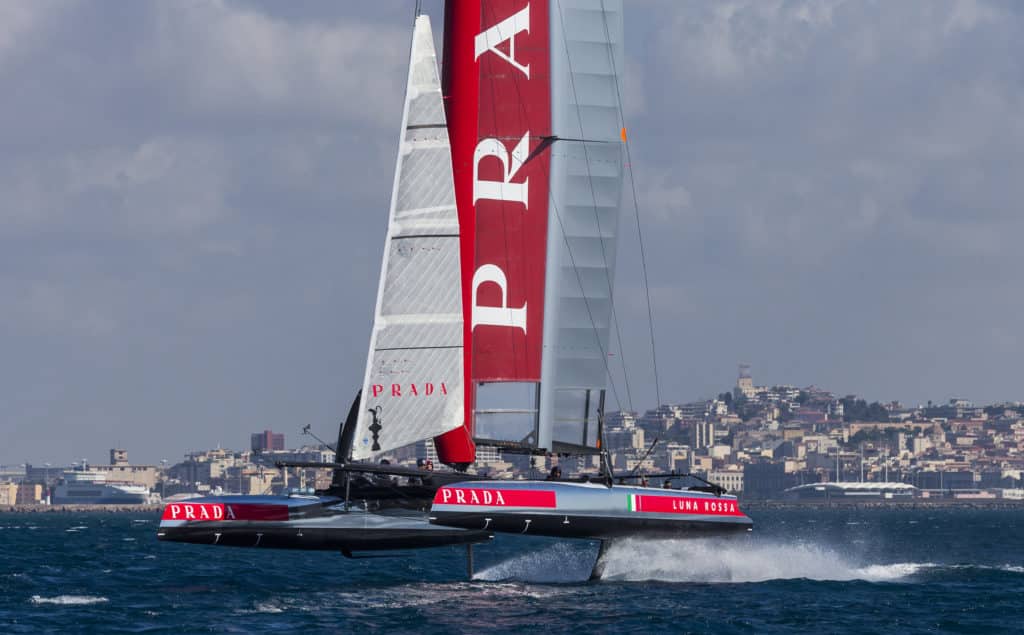
- More: America's Cup , Americas Cup 35 , Sailboat Racing
- More Racing
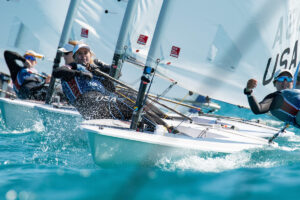
Reineke’s Battle For the Berth
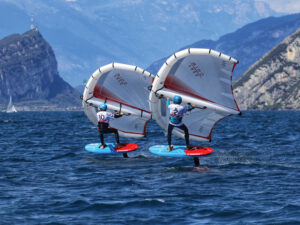
One-Design Wingfoil Racing Takes Off
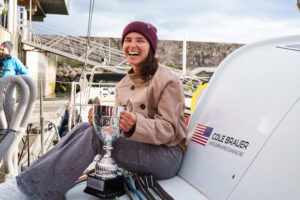
Brauer Sails into Hearts, Minds and History
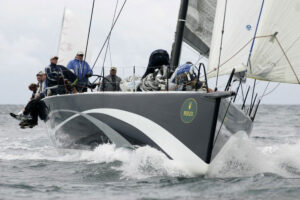
Anticipation and Temptation

America’s Offshore Couple

Jobson All-Star Juniors 2024: The Fast Generation

- Digital Edition
- Customer Service
- Privacy Policy
- Cruising World
- Sailing World
- Salt Water Sportsman
- Sport Fishing
- Wakeboarding
Trimaran Projects and Multihull News
Trimaran project is intended to showcase multihull news with a focus on racing, build projects, launchings, interesting ideas past and present and also updates on my own trimaran projects. Lots of content and updates to come so keep checking back.
Saturday 3 November 2012
Luna rossa's ac72 catamaran out on their first test sail..

No comments:
Post a comment.

Yachting World
- Digital Edition

America’s Cup: All the best images from the 36th Cup
- Toby Heppell
- March 17, 2021
We take a look back at a stunning 36th America's Cup in Auckland New Zealand, through the eyes of the photographers on the ground
On Wednesday 17th March 2021, Emirates New Zealand beat Luna Rossa Prada Pirelli 7-3 to win the 36th America’s Cup , successfully defending their 2017 victory in the event. The win makes this their fourth America’s Cup victory, following previous wins in 1995, 2000, and 2017.
Despite Covid-19 disrupting the build up to the event and keeping the public away from the America’s Cup race village for the opening days of the regatta, it has been in impressive 36th America’s Cup in a country that has long embraced the competition between friendly nations. It has also been one of only a few sporting events that has managed t be held with little disruption in 2020/2021
As Max Sirena, skipper and head of the Challenger of Record, Luna Rossa Prada Pirelli put it after racing: “ I would like to thank New Zealand. At this moment in time [with Covid-19] this is the only place we could have held this event in the world.”
Helmsman of Emirates Team New Zealand, Peter Burling added: “When you talk to friends overseas and we talk to our friends in the UK and America and Italy too, we see there is a lot of hardship going on and it is hard seeing the way Covid has changed the way in which we live. To still be able to put on an event like this, really that is full credit everyone who lives here, and to the government for trying to keep our country Covid free.
“Obviously we started the event in Level Two [Covid lockdown] and it has been amazing to get back to Level 1 so we could have a finish like [we saw] today with everyone in the race village.
The wait will now be on to see what the next America’s Cup will look like once a Challenger of Record (CoR) has been announced and the New Zealanders alongside that new CoR have decided on the boat, the rules and the venue.
However, the praise heaped on the newly conceived AC75 by all teams and many fans seems likely to seal the design’s position as the America’s Cup boat of choice for the 37th America’s Cup – or at least a slightly modified version.
“ It think the [AC75] has produced racing beyond our expectations, so we are really happy with it,” said Dan Bernasconi, who heads up the Emirates Team New Zealand design team.
“Everyone was a bit scared of this boat a couple of years ago [when it was first announced], but these boats sail extremely well and [are] really nice. I hope they stay in the future,” agreed Sirena.
If you enjoyed this….
Yachting World is the world’s leading magazine for bluewater cruisers and offshore sailors. Every month we have inspirational adventures and practical features to help you realise your sailing dreams. Build your knowledge with a subscription delivered to your door. See our latest offers and save at least 30% off the cover price.
- Nautic Shows
- America’s Cup
- Classic Yachts
- Motor Yachts
- Sailing Yachts
- Superyachts
- Yachts News
- Destinations
- Yacht Clubs
- Boat Racing
- Meta Yachts

The International Maxi Association’s 2023-24 Mediterranean Maxi Offshore Challenge starts this Saturday (21 October) with a huge, top quality maxi yacht line-up as part of the Royal Malta Yacht Club’s Rolex Middle Sea Race.
In the 44th edition of this ‘classic 600 mile’ anticlockwise lap of Sicily, starting and finishing off the Maltese capital Valletta, 17 maxi yachts of 60+ft LH are entered. In addition is Alexia Barrier’s outright line honours favourite, the MOD70 trimaran Limosa, sailed by her all-women’s Jules Verne Trophy (non-stop round the world record) team The Famous Project. They return to defend their title – in 2022 Limosa was Riccardo Pavoncelli’s Mana.
Among the monohulls, the scratch boat is Bryon Ehrhart’s Lucky, a boat which knows the way for as Rambler 88, under her original owner George David, she won line honours on five consecutive occasions between 2015 and 2019. Ehrhart has kept the majority of David’s crew, led by America’s Cup and offshore legend Brad Butterworth.
Personally Ehrhart holds a perfect track record in the Rolex Middle Sea Race – in 2010 he entered it in his TP52, also named Lucky, and impressively won overall under IRC on his first attempt. This will be his first time back. He says: “In 2010 it was such a tough race through every condition possible. Truly the race is a great test of sailing skill and we look forward to the test again this year. Thanks to Royal Malta Yacht Club and Rolex for keeping this event so strong for so many years. It is a classic!”
The longest maxi competing this year is the 107ft Paprec Sailing Team (aka Spirit of Malouen) skippered by Stéphane Névé. This started life as Sir Charles Dunstone’s Wallycento Hamilton, was then acquired by Thomas Bscher, extended to 107ft and renamed Open Season. She was sold to present owner Jean-Luc Petithuguenin, who has evolved her into being an offshore racer.
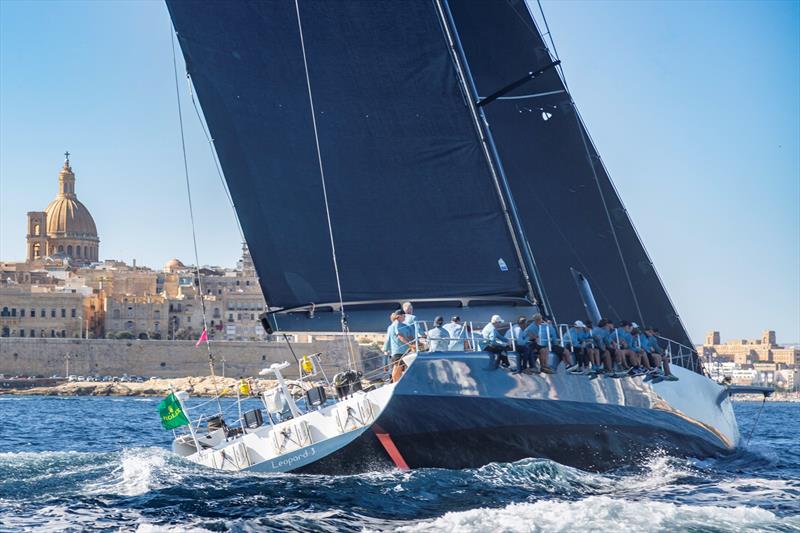
The 100ft Leopard 3 will be one to watch. Under original owner Mike Slade, Leopard 3 was transformed from a racer into a race cruiser. Under her present Dutch owner she has been transformed back. In a massive refit earlier this year her rig was replaced with one 350kg lighter, permitting bigger, longer luffed, jibs. The central part of her deck (mast back to main winch) and cabin top were replaced so she now has a tighter sheeting angle for her headsails. She has a full new winch package. In total she is now five tonnes lighter.
The mods are working as Leopard 3 won both line and overall honours in July’s Aegean 600. For the Rolex Middle Sea Race skipper Chris Sherlock says they have bolstered their crew, including re-recruiting Volvo Ocean Race skipper Neal McDonald as a watch leader. Tied to the nav station will again be Will Best.
Sherlock is impressed with this year’s maxi line-up: “It is a pretty hot fleet and there’s a lot of good guys on all the boats.” As to the conditions he says that the big breeze originally forecast for the first day is now passing through on Friday. After the start it is currently looking light and upwind: “Our routing is telling us we will be on our J0 and J2 for near on 90% of the race, so a lot of upwind stuff and light-medium, which is also good for Bullitt. But everyone is going to have their good spots in this race where they go really well, but the boats are so diverse, it will depend on how much of that ‘good stuff’ you get for your boat.”
Andrea Recordati’s Bullitt has also been under the knife. Compared to how she was last year, the Wally 93 is more powerful with improved downwind performance thanks to a longer bowsprit, increased mast rake and increased sail area. She also now has a fixed keel drawing 6m with the bulb further aft producing a more bow-up trim, further augmented by the two tonnes of water ballast she now has each side.
Making her Rolex Middle Sea Race debut this year is Roy P Disney’s Pyewacket 70 VO70, originally the 2011 vintage Telefonica. She was subsequently turboed when she was Peter Harburg’s all-conquering Black Jack, before Disney acquired her in 2019.
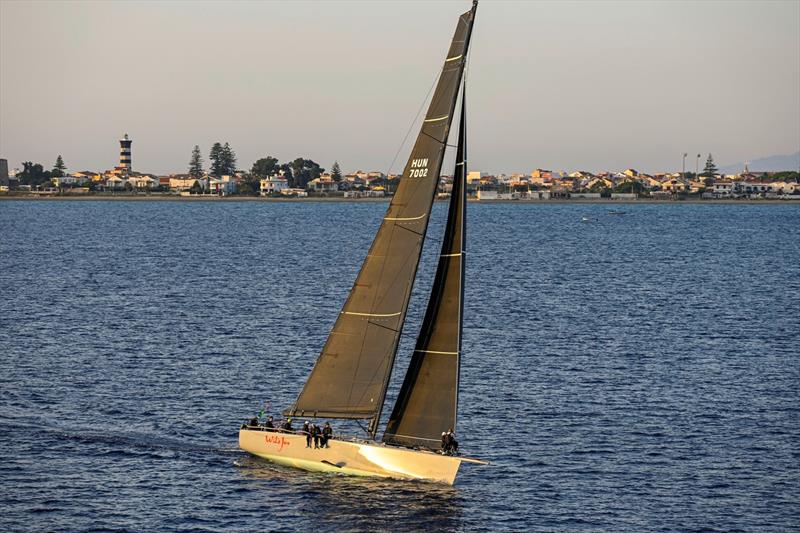
Disney, and his father Roy E before him, are and were enthusiastic Transpac competitors who pioneered the West Coast maxi sleds (ULDBs), then the maxZ86s. Roy P has personally raced 26 Transpacs… “My father for years and years had this on his list,” he says of the Rolex Middle Sea Race, a race his father ultimately never sailed. “It is a very romantic race. Everyone who does it talks about the beauty of it, all the way around and the finish is just amazing. I finally decided to close the loop. Now my boy is off to college, I have the time…” And Stromboli (the volcanic island the race passes) is a character from Pinocchio.
Aside from her success in the Transpac and other races on the US West Coast, Pyewacket 70 proved she is competitive by winning this spring’s RORC Caribbean 600 outright. “Because it is a Volvo boat, it gets more comfortable the more breeze there is!” Disney continues. “We are up against some 100 footers so we may not win on the water, but I think in the light air we are going to have them. Reaching we should be at least up with them.”
Surprisingly it will also be a first Rolex Middle Sea Race for Pyewacket 70’s legendary navigator Peter Isler (who started the heavy weather race in 2007 aboard Tom Hill’s maxi Titan 12, but then retired). “My expectation is to see a volcano, get the through the Strait and beat Lucky!” His forecast is similar to Sherlock’s: “It is a good navigator’s race. It is looking like it will be a broadish reach about half way to the Strait [Messina] and then a front goes through and once that clears it turns on the wind in the Strait with a fair bit of punch and then it’s westerly all along the top of a lot of Sicily. So a lot of upwind.”
In addition there are the usual array of former Volvo Ocean Race boats including the VO70s Ocean Breeze and Green Dragon and the VO65s Ambersail 2 and Sisi. Among the hot 60s are is the DSS-equipped Wild Joe sailed by Marton Jozsa and Guido Paolo Gamucci’s canting keel Mylius 60 Cippa Lippa X. For Jozsa and his largely Hungarian crew, the race will be their 12th Rolex Middle Sea Race.
More information at www.internationalmaxiassociation.com
- Rolex Middle Sea Race
RELATED ARTICLES
The united nations recognises the trofeo princesa sofía mallorca as a carbon neutral event, hetairos wins the round antigua race, éric péron finishes fifth and completes the circle in the arkéa ultim challenge – brest, antigua classic yacht regatta – preparing to set sail with many new and notable entries, anthony marchand on actual ultim 3 finishes fourth in the arkéa ultim challenge – brest.

Subscribe to our newsletter
To be updated with all the latest news, offers and special announcements.
LATEST ARTICLES
A sweltering sunday: light winds and looming storms on the red sea, sailgp’s christchurch return: race times and maps revealed as excitement grows, alinghi red bull racing embracing the spirit of dedication, editor picks, canadian beau lake introduces the tahoe ’14 and lugano ’14 electric runabouts, underwater adventure and exploration with deepflight’s super falcon 3s, driving performance on land and on water: 41′ amg carbon edition, popular posts, young designer of the year 2022: ioana valentina corcodel reveals 65m ophelia concept, mirabaud sailing video of the century: celebrating 2 decades of passion, superyacht the flying fox seized in the dominican republic, popular category.
- Regatta 805
- America's Cup 380
- Motor Yachts 260
- Boating 215
- Superyachts 181
- Sailing 176
- Yachts News 173
- Sailing Yachts 162

THE LUNA ROSSA COLLECTION
carlo borlenghi
Carlo Borlenghi was born on 1956 in Bellano (Como Lake) where he started his photography career following the local regattas. Still young, thanks to the collaboration with the magazine “Uomo Mare Vogue”, he travelled around the world, following the most important nautical events. He photographs all the national and international Rolex nautical events. Since 1983, he has photographed the America’s Cup regattas, following the endeavours of “ Azzurra ”. He follows America’s Cup’s campaigns:
- “ Azzurra ”, Newport (USA) – 1983
- “ Italia ”, Fremantle (Australia) – 1987
- “Stars and Stripes vs KZ1” , San Diego (USA) – 1988
- “ Moro di Venezia ”, San Diego (USA) – 1992
- “Team New Zealand vs Young America” , San Diego (USA) – 1995
- “ Luna Rossa ”, Auckland (New Zealand) – 2000
- “ Luna Rossa ”, Auckland (New Zealand) – 2003
- “ ACM ” Official Photographer for 32nd AC – 2007
- “ Alinghi ” Valencia (Spain) – 2010
- “ Luna Rossa ”, San Francisco (USA) – 2013
- “ BMW ”, Bermuda (USA) – 2017
- “ Luna Rossa ” – “ COR” – “ACM” , Auckland (New Zealand) – 2021
Since 1994 he follows Giovanni Soldini’s boats, round-the-worlds and adventures:
- “ Stupefacente Kodak ” (50 ft), 1994
- “ Telecom Italia ” (60 ft), 1996
- “ Tim Progetto Italia ” (Trimarano), from 2001
- “ Telecom Italia ” (40 ft), from 2007
He was the official photographer during several editions of the “Whitbread Round the World Race” for the following boats:
- “ Gatorade ” 89-90
- “ Brooksfield ” 93-94
- “ Merit Cup ” 93-94
- “ Merit ” 97-98
In 2000 he followed Grant Dalton’s “ Club Med ” for “The Race”. Official photographer of “ Amer Sport One ” and “ Amer Sport Too ” during the Volvo Ocean Race 2001-02.
Since several years he is the official photographer of nautical events for: “ Audi Melges Sailing Series “, “ Barcolana “, “ Dubois Cup “, “ Loro Piana Superyacht “, “ Perini Navi Cup “, “ Pirelli “, “ Yacht Club Monaco ” and “ China Cup ” in Shenzen.
His specialization doesn’t limit to the sport field, but also to the shipbuilding industry (brochures, catalogues and business portraits).
In 1983 Carlo Borlenghi won the “Marian Skubin” prize for the best Sports picture published in Italy. He won for three years the “Marina di Pescara” award for the diffusion of yachting in Italy.
In 1986, in Paris, he won the “Grand Prix Professional de la photo de Mer” organised by the French Chamber of Commerce. In 2003 he won the Omega price for the best italian sport photographer.
In 2007 he won the price “Grand Prix de l’Image Course au Large” Salon Nautique de Paris 2007.
In 2007 he received ‘for the years he has dedicated to the sail world” a plaque from the President of the Italian Repubblic Giorgio Napolitano.
In 1989, Carlo Borlenghi created the photographic agency “Sea&See” Italy, specialized in water sports, now made over to the Mediatree Group.
In 2007 he exhibited at Space Louis Vuitton in Paris for the show ‘Winds and Sails’ dedicated to the America’s Cup.
Between 2005 and 2007 he presented his images in a travel exhibition in Malmo, Trapani, Valencia, Geneva and Madrid.
In 2012 he already made an exhibition in Paris at Mairie XVI Arrondissement.
In 2015 he exhibited in Milano at “Spazio Dream Factory”.
In 2015 he exhibited at “Arsenale di Iseo”.
Every years he publishes many books and calendars which are always related to the sea and he collaborates with the most prestigious nautical magazines and newspapers.
His never ending enthusiasm leads him to be always open-minded towards new adventures and innovations and to be continuosly updated in the photographic and technological fields.
Carlo Borlenghi nasce a Bellano sul Lago di Como dove inizia la sua carriera di fotografo seguendo le regate locali. Ancora giovane, grazie alla passione per il mare e alla collaborazione con la rivista “Uomo Mare Vogue”, gira il mondo seguendo i più importanti eventi internazionali di nautica. A soli 27 anni, nel 1983 segue le imprese di “Azzurra” la prima barca italiana che partecipa all’America’s Cup a Newport R.I. (USA). Da allora ha seguito diverse campagne di Coppa America:
Fotografa gli eventi nautici internazionali Rolex.
Dal 1994 segue le barche, i giri del mondo e le avventure di Giovanni Soldini:
- “ Telecom Italia ” (40 ft),from 2007
Ha inoltre seguito diverse edizioni del “Whitbread Round the World Race”:
Nel 2000 è stato il fotografo di “ Club Med ” di Grant Dalton vincitore di “ The Race ” il giro del mondo in catamarano senza scalo e senza assistenza.
Fotografo ufficiale di “ Amer Sports One ” e “ Amer Sports Too ” durante la Volvo Ocean Race 2001-02.
Nel 1983 ha ottenuto il premio “Marian Skubin”per la migliore fotografia sportiva pubblicata in Italia. Vincitore per tre anni consecutivi del premio “Marina di Pescara” per la divulgazione della fotografia nautica in Italia.
Nel 1986 ha vinto a Parigi il “Grand Prix Professional de la photo de Mer” organizzato dalla Camera di Commercio Francese.
Nel 2003 vince il premio “Omega Fotocronache”, come miglior fotografo sportivo.
Nel 2007 vince il premio ‘Grand Prix de l’Image Course au Large’ – Salon Nautique de Paris 2007.
Nel 2007 riceve ‘per i molti anni di intensa attività a favore del mondo della vela’ una targa del Presidente della Repubblica Giorgio Napolitano.
Nel 2007 espone allo spazio Louis Vuitton di Parigi per la mostra fotografica Winds and Sails dedicata alla Coppa America.
Nel 2012 mostra personale a Parigi – Marie du XVI Arrondissement.
Nel 2015 mostra personale a Milano spazio Dream Factory.
Nel 2015 mostra personale all’Arsenale di Iseo.
Pubblica ogni anno libri e calendari dedicati al mare. Collabora stabilmente con i più importanti quotidiani italiani e stranieri e con testate internazionali.
L’entusiasmo e la passione sono alla base della sua filosofia professionale. Aperto all’innovazione e sempre disponibile a nuove avventure è affiancato da un team di collaboratori giovani e motivati insieme ai quali si aggiorna continuamente sia nel campo della fotografia che in quello della tecnologia.
Privacy Overview
Take advantage of the search to browse through the World Heritage Centre information.
Share on social media
Unesco social media, kremlin and red square, moscow.
- Description
Inextricably linked to all the most important historical and political events in Russia since the 13th century, the Kremlin (built between the 14th and 17th centuries by outstanding Russian and foreign architects) was the residence of the Great Prince and also a religious centre. At the foot of its ramparts, on Red Square, St Basil's Basilica is one of the most beautiful Russian Orthodox monuments.
Description is available under license CC-BY-SA IGO 3.0
Le Kremlin et la place Rouge, Moscou
Indissolublement lié à tous les événements historiques et politiques les plus importants survenus en Russie depuis le XIII e siècle, le Kremlin a été construit entre le XIV e et le XVII e siècle par des architectes russes et étrangers exceptionnels. C'était la résidence du grand-prince ainsi qu'un centre religieux. Au pied de ses remparts, sur la place Rouge, s'élève la basilique Basile-le-Bienheureux, l'un des plus beaux monuments de l'art orthodoxe.
الكرملين والساحة الحمراء، موسكو
يرتبط الكرملين ارتباطاً وثيقاً بجميع الأحداث التاريخيّة والسياسيّة المهمّة التي توالت على روسيا منذ القرن الثالث عشر ولقد جرى تشييده بين القرنين الرابع والسابع عشر على يد مهندسين روس وأجانب استثنائيين. وكان الكرملين مقرّ الأمير الكبير كما كان مركزاً دينيّاً. عند أسفل أسواره في الساحة الحمراء شيدت بازيليك القديس بازيل وهي من أروع تحف الفنّ الأرثوذكسي.
source: UNESCO/CPE Description is available under license CC-BY-SA IGO 3.0
莫斯科克里姆林宫和红场
由俄罗斯和外国建筑家于14世纪至17世纪共同修建的克里姆林宫,作为沙皇的住宅和宗教中心,与13世纪以来俄罗斯所有最重要的历史事件和政治事件密不可分。在红场上防御城墙的脚下坐落的圣瓦西里教堂是俄罗斯传统艺术最漂亮的代表作之一。
El kremlin y la Plaza Roja de Moscú
Indisolublemente vinculado a los más trascendentales acontecimientos históricos y políticos de Rusia desde el siglo XIII, el kremlin de Moscú fue construido entre los siglos XIV y XVII por toda una serie de excelentes arquitectos rusos y extranjeros. Además de ser la residencia del Gran Príncipe, fue un importante centro religioso. Al pie de sus murallas, en la Plaza Roja, se alza la basílica de San Basilio el Bienaventurado, uno de los más hermosos monumentos de arte ortodoxo.
モスクワのクレムリンと赤の広場
source: NFUAJ
Kremlin en Rode Plein, Moskou
Het Kremlin is onlosmakelijk verbonden met alle belangrijke historische en politieke gebeurtenissen in Rusland sinds de 13e eeuw. Het werd door de Grote Prins Yuri van Kiev gesticht als residentie en religieus centrum. De bouw vond plaats tussen de 14e en 17e eeuw en het ontwerp was in handen van uitstekende Russische en buitenlandse architecten. Binnen de muren van het Kremlin vindt men een reeks meesterwerken qua architectuur, maar ook beeldende kunst en religieuze monumenten van uitzonderlijke schoonheid. Aan de voet van de stadsmuren, op het Rode Plein, bevindt zich een van de mooiste Russisch-orthodoxe monumenten, de Pokrovkathedraal ook wel Basiliuskathedraal genoemd.
Source: unesco.nl

Outstanding Universal Value
Brief synthesis
At the geographic and historic centre of Moscow, the Moscow Kremlin is the oldest part of the city. First mentioned in the Hypatian Chronicle in 1147 as a fortification erected on the left bank of the Moskva river by Yuri Dolgoruki, Prince of Suzdal, the Kremlin developed and grew with settlements and suburbs which were further surrounded by new fortifications - Kitaigorodsky Wall, Bely Gorod, Zemlyanoy Gorod and others. This determined a radial and circular plan of the centre of Moscow typical of many other Old Russian cities.
In 13th century the Kremlin was the official residence of supreme power - the center of temporal and spiritual life of the state. The Kremlin of the late 15th – early 16th century is one of the major fortifications of Europe (the stone walls and towers of present day were erected in 1485–1516). It contains an ensemble of monuments of outstanding quality.
The most significant churches of the Moscow Kremlin are situated on the Cathedral Square; they are the Cathedral of the Dormition, Church of the Archangel, Church of the Annunciation and the bell tower of Ivan Veliki. Almost all of them were designed by invited Italian architects which is clearly seen in their architectural style. The five-domed Assumption Cathedral (1475–1479) was built by an Italian architect Aristotele Fiorvanti. Its interior is decorated with frescos and a five-tier iconostasis (15th–17th century). The cathedral became the major Russian Orthodox church; a wedding and coronation place for great princes, tsars and emperors as well as the shrine for metropolitans and patriarchs.
In the same square another Italian architect, Alevisio Novi, erected the five-domed Church of the Archangel in 1505-1508. From the 17th to 19th century, its interior was decorated by wonderful frescos and an iconostasis. In this church many great princes and tsars of Moscow are buried. Among them are Ivan I Kalita, Dmitri Donskoi, Ivan III, Ivan IV the Terrible, Mikhail Fedorovich and Alexei Mikhailovich Romanovs.
The Cathedral of the Dormition was built by Pskov architects in 1484–1489. Inside the cathedral some mural paintings of 16th–19th century have been preserved and the icons of Andrei Rublev and Theophanes the Greek are part of the iconostasis.
In 1505-1508 the bell tower of Ivan Veliki was built. Being 82 metres high it was the highest building in Russia which became the focal point of the Kremlin ensemble.
Among the oldest civil buildings of the Moscow Kremlin, the Palace of the Facets (1487–1491) is the most remarkable. Italian architects Marco Fryazin and Pietro Antonio Solario built it as a great hall for holding state ceremonies, celebrations and for receiving foreign ambassadors. The most noteworthy civil construction of the 17th century built by Russian masters is the Teremnoi Palace.
From the early 18th century, when the capital of Russia moved to St. Petersburg, the Kremlin mainly played a ceremonial role with religious functions. By the end of the century the architectural complex of the Kremlin expanded with the Arsenal reconstructed after the Fire of 1797 by Matvei Kazakov. The Senate was built in 1776–1787 according to the plans of the same architect as the home of the highest agency of State power of the Russian Empire - the Ruling Senate. Today it is the residence of the President of Russia.
From 1839 to 1849 a Russian architect K.A. Thon erected the Great Kremlin Palace as a residence of the imperial family which combined ancient Kremlin buildings such as the Palace of the Facets, the Tsarina’s Golden Chamber, Master Chambers, the Teremnoi Palace and the Teremnoi churches. In the Armory Chamber built by K.A. Thon within the complex of the Great Kremlin Palace, there is a 16th century museum officially established by the order of Alexander I in 1806.
Red Square, closely associated with the Kremlin, lies beneath its east wall. At its south end is the famous Pokrovski Cathedral (Cathedral of St Basil the Blessed), one of the most beautiful monuments of Old Russian church architecture, erected in 1555–1560 to commemorate the victory of Ivan the Terrible over the Kazan Khanate. In the 17th century the cathedral gained its up-to-date appearance thanks to the decorative finishing of the domes and painting both inside and outside the cathedral. The construction of Red Square was finished by the late 19th century together with the erection of the Imperial Historic Museum (today the State Historical Museum), the Upper Trading Rows (GUM) and the Middle Trading Rows. In 1929, , Lenin’s Mausoleum, designed by A.V. Shchusev and an outstanding example of the Soviet monumental architecture, was finished.
Criterion (i) : The Kremlin contains within its walls a unique series of masterpieces of architecture and the plastic arts. There are religious monuments of exceptional beauty such as the Church of the Annunciation, the Cathedral of the Dormition, the Church of the Archangel and the bell tower of Ivan Veliki; there are palaces such as the Great Palace of the Kremlin, which comprises within its walls the Church of the Nativity of the Virgin and the Teremnoi Palace. On Red Square is Saint Basil the Blessed, still a major edifice of Russian Orthodox art.
Criterion (ii) : Throughout its history, Russian architecture has clearly been affected many times by influences emanating from the Kremlin. A particular example was the Italian Renaissance. The influence of the style was clearly felt when Rudolfo Aristotele Fioravanti built the Cathedral of the Dormition (1475-79) and grew stronger with the construction of the Granovitaya Palace (Hall of the Facets, 1487-91) by Marco Fryazin and Pietro Antonio Solario. Italian Renaissance also influenced the towers of the fortified enceinte, built during the same period by Solario, using principles established by Milanese engineers (the Nikolskaya and the Spasskaya Towers both date from 1491). The Renaissance expression was even more present in the classic capitals and shells of the Church of the Archangel, reconstructed from 1505 to 1509 by Alevisio Novi.
Criterion (iv) : With its triangular enceinte pierced by four gates and reinforced with 20 towers, the Moscow Kremlin preserves the memory of the wooden fortifications erected by Yuri Dolgoruki around 1156 on the hill at the confluence of the Moskova and Neglinnaya rivers (the Alexander Garden now covers the latter). By its layout and its history of transformations (in the 14th century Dimitri Donskoi had an enceinte of logs built, then the first stone wall), the Moscow Kremlin is the prototype of a Kremlin - the citadel at the centre of Old Russian towns such as Pskov, Tula, Kazan or Smolensk.
Criterion (vi) : From the 13th century to the founding of St Petersburg, the Moscow Kremlin was directly and tangibly associated with every major event in Russian history. A 200-year period of obscurity ended in 1918 when it became the seat of government again. The Mausoleum of Lenin on Red Square is the Soviet Union’s prime example of symbolic monumental architecture. To proclaim the universal significance of the Russian revolution, the funerary urns of heroes of the revolution were incorporated into the Kremlin’s walls between the Nikolskaya and Spasskaya towers. The site thus combines in an exceptional manner the preserved vestiges of bygone days with present-day signs of one of the greatest events in modern history.
From the date of including the Moscow Kremlin and Red Square on the World Heritage List all the components representing the Outstanding Universal Value of the property are within its boundaries. The territory and the integrity of the World Heritage property have also remained unchanged. Within its boundaries the property still comprises all the elements that it contained at the date of nomination. The biggest threat, however, is unregulated commercial development of the adjacent areas.
Authenticity
The history of the Moscow Kremlin and Red Square is reflected in the archival documents of 12th–19th century, for example in medieval chronicles, cadastral surveys, estimated construction books, painted lists, inventories, foreign notes and in graphic matters such as manuscripts, chronicles, plans, drafts, engravings, lithographs, sketches of foreign travelers, paintings and photographs. These documents are exceptionally valuable information sources. Comparison of the data received from archival documents and those obtained in the process of field study gives the idea of authenticity of the property and its different elements. This comparison also serves as the basis for project development and for the choice of the appropriate methods of restoration that may preserve the monuments’ authenticity.
On the border of the ensemble a number of monuments destroyed in the 1930s were reconstructed according to measured plans.
Protection and management requirements
The statutory and institutional framework of an effective protection, management and improvement of the World Heritage property “Kremlin and Red Square, Moscow” has been established by laws and regulations of the Russian Federation and the city of Moscow.
According to the decree of the President of RSFSR of 18 December 1991 № 294, the Moscow Kremlin was included among especially protected cultural properties of nations of Russia - the highest conservation status for cultural and historical monuments in Russian legislation.
“Kremlin and Red Square, Moscow” is a Cultural Heritage Site of federal importance. State protection and management of federal sites is provided by Federal Law of 25.06.2002 № 73-FZ “On cultural heritage sites (historical and cultural monuments) of nations of the Russian Federation”. The federal executive body responsible for protection of the cultural property is the Department for Control, Supervision and Licensing in the Cultural Heritage Sphere of the Ministry of Culture of the Russian Federation.It is in charge of all methodological and control functions concerning restoration, usage and support of cultural heritage sites and the territories connected.
The World Heritage property is situated in the urban environment of Moscow. The city policy regarding cultural heritage protection and town-planning regulation is the responsibility of Moscow City Government, represented by the Department of Cultural Heritage, the Department of Urban Development and the Committee for Urban Development and Architecture of Moscow. In 1997 the boundaries of the protective (buffer) zone were approved in order to preserve the property, and to maintain and restore the historical architectural environment as well as the integral visual perception of the property.. There is a need to ensure the creation of an appropriate buffer zone and to develop close liaison between all stakeholders, including the Moscow City authorities, to ensure that constructions around the property do not impact adversely on its Outstanding Universal Value.
The World Heritage property is used by the following organizations: FGBUK (Federal Government Budgetary Institution of Culture), the State Historical and Cultural Museum-preserve “The Moscow Kremlin”, the Administrative Department of the President of the Russian Federation, the Federal Guard Service of the Russian Federation and OJSC “GUM Department Store”.
- Official site of 'The Moscow Kremlin' State Historical and Cultural Museum and Heritage Site
- Moscow Kremlin Museums Telegram Group (in Russian only)
- Moscow Kremlin Museums VKontakte Page (in Russian only)
- Moscow Kremlin Museums Dzen Page (in Russian only)
- State Historical Museum VKontakte Group (in Russian only)
- Msk Guide Page (in Russian only)
- Official site of the State Department Store
- State Historical Museum (in Russian only)

State of Conservation (SOC)
- Election 2024
- Entertainment
- Newsletters
- Photography
- Personal Finance
- AP Buyline Personal Finance
- Press Releases
- Israel-Hamas War
- Russia-Ukraine War
- Global elections
- Asia Pacific
- Latin America
- Middle East
- March Madness
- AP Top 25 Poll
- Movie reviews
- Book reviews
- Personal finance
- Financial Markets
- Business Highlights
- Financial wellness
- Artificial Intelligence
- Social Media
Inside Russia’s penal colonies: A look at life for political prisoners caught in Putin’s crackdowns

FILE In this file photo made from video provided by the Moscow City Court on Feb. 3, 2021, Russian opposition leader Alexei Navalny makes a heart gesture standing in a cage during a hearing to a motion from the Russian prison service to convert the suspended sentence of Navalny from the 2014 criminal conviction into a real prison term in the Moscow City Court in Moscow, Russia. Navalny, President Vladimir Putin’s fiercest foe, has become Russia’s most famous political prisoner. He is serving a nine-year term due to end in 2030 on charges widely seen as trumped up, and is facing another trial on new charges that could keep him locked up for another two decades. (Moscow City Court via AP, File)
FILE Russian opposition leader Alexei Navalny looks at photographers standing behind a glass of the cage in the Babuskinsky District Court in Moscow, Russia, on Feb. 20, 2021. Navalny, President Vladimir Putin’s fiercest foe, has become Russia’s most famous political prisoner. He is serving a nine-year term due to end in 2030 on charges widely seen as trumped up, and is facing another trial on new charges that could keep him locked up for another two decades. (AP Photo/Alexander Zemlianichenko, File)
FILE - Detained protesters are escorted by police during a protest against the jailing of opposition leader Alexei Navalny in St. Petersburg, Russia, on Jan. 31, 2021. Memorial, Russia’s oldest and most prominent human rights organization and a 2022 Nobel Peace Prize laureate, counted 558 political prisoners in the country as of April -- more than three times higher than in 2018, when it listed 183. (AP Photo, File)
FILE - Opposition leader Alexey Navalny, speaks with riot police officers blocking the way during a protest rally against Prime Minister Vladimir Putin’s rule in St. Petersburg, Russia, on Feb. 25, 2012. Navalny, President Vladimir Putin’s fiercest foe, has become Russia’s most famous political prisoner. He is serving a nine-year term due to end in 2030 on charges widely seen as trumped up, and is facing another trial on new charges that could keep him locked up for another two decades. (AP Photo, File)
FILE - Police block a protest against the jailing of opposition leader Alexei Navalny in Yekaterinburg, Russia, on Jan. 23, 2021. Memorial, Russia’s oldest and most prominent human rights organization and a 2022 Nobel Peace Prize laureate, counted 558 political prisoners in the country as of April -- more than three times higher than in 2018, when it listed 183. (AP Photo, file)
FILE Sasha Skochilenko, a 32-year-old artist and musician, stands in a defendant’s cage in a courtroom during a hearing in the Vasileostrovsky district court in St. Petersburg, Russia, on April 13, 2022. Skochilenko is in detention amid her ongoing trial following her April 2022 arrest in St. Petersburg on the charges of spreading false information about the army. She has spent over a year behind bars. (AP Photo, File)
FILE - Russian opposition activist Vladimir Kara-Murza is escorted to a hearing in a court in Moscow, Russia, Feb. 8, 2023. Kara-Murza, another top Russian opposition figure, was sentenced last month to 25 years on treason charges. (AP Photo, File)
FILE In this handout photo released by the Moscow City Court, Russian opposition activist Vladimir Kara-Murza stands in a glass cage in a courtroom at the Moscow City Court in Moscow, on April 17, 2023. Kara-Murza, another top Russian opposition figure, was sentenced last month to 25 years on treason charges. (The Moscow City Court via AP, File)
FILE - Alexei Gorinov holds a sign “I am against the war” standing in a cage during hearing in the courtroom in Moscow, Russia, on June 21, 2022. Gorinov, a former member of a Moscow municipal council, was convicted of “spreading false information” about the army in July over antiwar remarks he made at a council session. Criticism of the invasion was criminalized a few months earlier, and Gorinov, 61, became the first Russian sent to prison for it, receiving seven years. (AP Photo, File)
FILE - Andrei Pivovarov, former head of Open Russia movement stands behind the glass during a court session in Krasnodar, Russia, on June 2, 2021. Pivovarov, an opposition figure sentenced last year to four years in prison, has been in isolation at Penal Colony No. 7 in northern Russia’s Karelia region since January and is likely to stay there the rest of this year. (AP Photo, File)
FILE - Andrei Pivovarov, former head of Open Russia movement, speaks with media in Moscow, Russia, on July 9, 2020. Pivovarov, an opposition figure sentenced last year to four years in prison, has been in isolation at Penal Colony No. 7 in northern Russia’s Karelia region since January and is likely to stay there the rest of this year. (AP Photo/Denis Kaminev, File)
FILE - Riot police detain two young men at a demonstration in Moscow, Russia, on Sept. 21, 2022. Memorial, Russia’s oldest and most prominent human rights organization and a 2022 Nobel Peace Prize laureate, counted 558 political prisoners in the country as of April -- more than three times higher than in 2018, when it listed 183. (AP Photo, File)
- Copy Link copied
TALLINN, Estonia (AP) — When Alexei Navalny turns 47 on Sunday, he’ll wake up in a bare concrete cell with hardly any natural light.
He won’t be able to see or talk to any of his loved ones. Phone calls and visits are banned for those in “punishment isolation” cells, a 2-by-3-meter (6 1/2-by-10-foot) space. Guards usually blast patriotic songs and speeches by President Vladimir Putin at him.
“Guess who is the champion of listening to Putin’s speeches? Who listens to them for hours and falls asleep to them?” Navalny said recently in a typically sardonic social media post via his attorneys from Penal Colony No. 6 in the Vladimir region east of Moscow.
He is serving a nine-year term due to end in 2030 on charges widely seen as trumped up, and is facing another trial on new charges that could keep him locked up for another two decades. Rallies have been called for Sunday in Russia to support him.
Navalny has become Russia’s most famous political prisoner — and not just because of his prominence as Putin’s fiercest political foe, his poisoning that he blames on the Kremlin, and his being the subject of an Oscar-winning documentary.
He has chronicled his arbitrary placement in isolation, where he has spent almost six months. He’s on a meager prison diet, restricted on how much time he can spend writing letters and forced at times to live with a cellmate with poor personal hygiene, making life even more miserable.
Most of the attention goes to Navalny and other high-profile figures like Vladimir Kara-Murza , who was sentenced last month to 25 years on treason charges. But there’s a growing number of less-famous prisoners who are serving time in similarly harsh conditions.
Memorial, Russia’s oldest and most prominent human rights organization and a 2022 Nobel Peace Prize laureate, counted 558 political prisoners in the country as of April — more than three times the figure than in 2018, when it listed 183.
The Soviet Union’s far-flung gulag system of prison camps provided inmate labor to develop industries such as mining and logging. While conditions vary among modern-day penal colonies , Russian law still permits prisoners to work on jobs like sewing uniforms for soldiers.
In a 2021 report, the U.S. State Department said conditions in Russian prisons and detention centers “were often harsh and life threatening. Overcrowding, abuse by guards and inmates, limited access to health care, food shortages and inadequate sanitation were common in prisons, penal colonies, and other detention facilities.”
Andrei Pivovarov , an opposition figure sentenced last year to four years in prison, has been in isolation at Penal Colony No. 7 in northern Russia’s Karelia region since January and is likely to stay there the rest of this year, said his partner, Tatyana Usmanova. The institution is notorious for its harsh conditions and reports of torture.
The 41-year-old former head of the pro-democracy group Open Russia spends his days alone in a small cell in a “strict detention” unit, and is not allowed any calls or visits from anyone but his lawyers, Usmanova told The Associated Press. He can get one book from the prison library, can write letters for several hours a day and is permitted 90 minutes outdoors, she said.
Other inmates are prohibited from making eye contact with Pivovarov in the corridors, contributing to his “maximum isolation,” she said.
“It wasn’t enough to sentence him to a real prison term. They are also trying to ruin his life there,” Usmanova added.
Pivovarov was pulled off a Warsaw-bound flight just before takeoff from St. Petersburg in May 2021 and taken to the southern city of Krasnodar. Authorities accused him of engaging with an “undesirable” organization -– a crime since 2015.
Several days before his arrest, Open Russia had disbanded after getting the “undesirable” label.
After his trial in Krasnodar, the St. Petersburg native was convicted and sentenced in July, when Russia’s war in Ukraine and Putin’s sweeping crackdown on dissent were in full swing.
He told AP in a letter from Krasnodar in December that authorities moved him there “to hide me farther away” from his hometown and Moscow. That interview was one of the last Pivovarov was able to give, describing prison life there as “boring and depressing,” with his only diversion being an hour-long walk in a small yard. “Lucky” inmates with cash in their accounts can shop at a prison store once a week for 10 minutes but otherwise must stay in their cells, he wrote.
Letters from supporters lift his spirits, he said. Many people wrote that they used to be uninterested in Russian politics, according to Pivovarov, and “only now are starting to see clearly.”
Now, any letters take weeks to arrive, Usmanova said.
Conditions are easier for some less-famous political prisoners like Alexei Gorinov , a former member of a Moscow municipal council. He was was convicted of “spreading false information” about the army in July over antiwar remarks he made at a council session.
Criticism of the invasion was criminalized a few months earlier, and Gorinov, 61, became the first Russian sent to prison for it, receiving seven years.
He is housed in barracks with about 50 others in his unit at Penal Colony No. 2 in the Vladimir region, Gorinov said in written answers passed to AP in March.
The long sentence for a low-profile activist shocked many, and Gorinov said “authorities needed an example they could showcase to others (of) an ordinary person, rather than a public figure.”
Inmates in his unit can watch TV, and play chess, backgammon or table tennis. There’s a small kitchen to brew tea or coffee between meals, and they can have food from personal supplies.
But Gorinov said prison officials still carry out “enhanced control” of the unit, and he and two other inmates get special checks every two hours, since they’ve been labeled “prone to escape.”
There is little medical help, he said.
“Right now, I’m not feeling all that well, as I can’t recover from bronchitis,” he said, adding that he needed treatment for pneumonia last winter at another prison’s hospital ward, because at Penal Colony No. 2, the most they can do is “break a fever.”
Also suffering health problems is artist and musician Sasha Skochilenko, who is detained amid her ongoing trial following her April 2022 arrest in St. Petersburg, also on charges of spreading false information about the army. Her crime was replacing supermarket price tags with antiwar slogans in protest.
Skochilenko has a congenital heart defect and celiac disease, requiring a gluten-free diet. She gets food parcels weekly, but there is a weight limit, and the 32-year-old can’t eat “half the things they give her there,” said her partner, Sophia Subbotina.
There’s a stark difference between detention facilities for women and men, and Skochilenko has it easier in some ways than male prisoners, Subbotina said.
“Oddly enough, the staff are mostly nice. Mostly they are women, they are quite friendly, they will give helpful tips and they have a very good attitude toward Sasha,” Subbotina told AP by phone.
“Often they support Sasha, they tell her: ‘You will definitely get out of here soon, this is so unfair here.’ They know about our relationship and they are fine with it. They’re very humane,” she said.
There’s no political propaganda in the jail and dance music blares from a radio. Cooking shows play on TV. Skochilenko “wouldn’t watch them in normal life, but in jail, it’s a distraction,” Subbotina said.
She recently arranged for an outside cardiologist to examine Skochilneko and since March has been allowed to visit her twice a month.
Subbotina gets emotional when she recalled their first visit.
“It is a complex and weird feeling when you’ve been living with a person. Sasha and I have been together for over six years — waking up with them, falling asleep with them — then not being able to see them for a year,” she said. “I was nervous when I went to visit her. I didn’t know what I would say to Sasha, but in the end, it went really well.”
Still, Subbotina said a year behind bars has been hard on Skochilenko. The trial is moving slowly, unlike usually swift proceedings for high-profile political activists, with guilty verdicts almost a certainty.
Skochilenko faces up to 10 years if convicted.

IMAGES
VIDEO
COMMENTS
Luna Rossa, the wind gives the power It is easy to find things in common between a car and a motor boat. It is less simple when the boat is a sailing yacht: the hull (or the hulls, in the case of a catamaran or a trimaran) corresponds to the chassis and the set of sails - including the mast - matches the propeller.
Luna Rossa Prada Pirelli will now face Emirates Team New Zealand from 6th to 15th March. This is the big one, the event for which all teams have been training for the last 4 years.
It was the day we saw the return of American Magic to the racecourse in the Prada Cup, but Luna Rossa looked ominously good taking both wins. ... Ocean 50 trimaran sails home on one float. More news.
Luna Rossa Prada Pirelli, originally named Prada Challenge, then Luna Rossa Challenge, is an Italian sailboat racing syndicate first created to compete for the 2000 America's Cup.It won the Louis Vuitton Cup on its first attempt in 2000, but then lost the America's Cup match against the defending champion team, Team New Zealand.. Luna Rossa was challenged again for the 2003 America's Cup but ...
A World Speed Sailing Record was set in 2009 of 51.36 knots by Alain Thebault in his early foiling trimaran, ... Emirates Team New Zealand and Luna Rossa Prada Pirelli respectively, ...
Watch the race live on TV to share the thrill and the adrenaline of the regatta with the Luna Rossa Prada Pirelli team. WATCH ON TV In Italy all races (including the Preliminary Regattas) will be broadcast live on Mediaset Channel 20 and on Sky's dedicated channels (Sky Sport Arena 204 & Sky Sport 200).
A good start from both teams with Luna Rossa in commanding position. From there on it was a Match Race & Sailing Master Class by then entire Prada crew. Designers and shore team have delivered a good consistent AC75 to their crew Team, it performs in light winds and in the breeze is fast too, but Team New Zealand's is clear a faster boat.
the power. Luna Rossa, the wind gives. the power. It is easy to find things in common between a car and a motor boat. It is less simple when the boat is a sailing yacht: the hull (or the hulls, in the case of a catamaran or a trimaran) corresponds to the chassis and the set of sails - including the mast - matches the propeller.
On Water Recon Unit Notes: The Luna Rossa Prada Pirelli branded AC40-6 rolled out at 9:45 and the shore crew started right away with the mast stepping procedure.Once craned in at 10:30, the team seemed to conduct overall routine checks such as board rise/drop, sail controls and below deck tests including some structural testing.
A great first session of 2023 for Luna Rossa Prada Pirelli. On Water Recon Unit Notes: The LRPP LEQ12 sailed offshore covering 67.7 nm with sea state due to which the recon RIB struggled to keep up with the LEQ12 pace.
37th America's Cup Luna Rossa Prada Pirelli Team Luna Rossa Prototype LEQ12. No much time as in the past to update the web on every major event and little late on AC37 updates, but a cut from 2nd video above of Luna Rossa I saw at AC official Twitter account was pretty impressive thus wanted to have these updates from LR posted. Weapon.
In a statement on its official webpage, Team Luna Rossa has announced their withdrawal from the 35th America's Cup.This follows yesterday's vote by the participating teams to introduce a new ...
Trimaran project is intended to showcase multihull news with a focus on racing, build projects, launchings, interesting ideas past and present and also updates on my own trimaran projects. ... Luna Rossa was on the water until about 5.00pm for a good day's sailing. The world's top sailing photographer, Carlo Borlengi was on hand to catch the ...
On Wednesday 17th March 2021, Emirates New Zealand beat Luna Rossa Prada Pirelli 7-3 to win the 36th America's Cup, successfully defending their 2017 victory in the event. The win makes this ...
Skipper Massimiliano "Max" Sirena has been with Luna Rossa through every campaign since 2000. In 2010 he also helped Larry Ellison win the Cup, sailing as mast manager on the big trimaran. As of press time, a pair of British 49er aces—Chris Draper and Paul Campbell-James—was still sharing helming duties.
In addition is Alexia Barrier's outright line honours favourite, the MOD70 trimaran Limosa, sailed by her all-women's Jules Verne Trophy (non-stop round the world record) team The Famous Project. ... Luna Rossa's AC75 Departs Persico Marine En Route to Cagliari. March 15, 2024. Alinghi Red Bull Racing Takes Advantage of Training ...
580 m 2 (6,200 sq ft) (wing and gennaker estimate) [ edit on Wikidata] The AC72 ( America's Cup 72 class) is a class of wingsail catamarans built to a box rule, which governs the construction and operation of yachts competing in the 2013 Louis Vuitton and the America's Cup races. The class was subsequently replaced by the smaller AC50 class.
The America's Cup was held in Auckland in 2000 and was successfully defended by the New Zealanders against Luna Rossa. The next edition in 2003 was won, once again in Auckland, by the newly-formed Swiss team Alinghi, who brought the Cup back Europe after an absence of 152 years. ... to subsequently lose it to the Oracle Team USA trimaran in ...
"Luna Rossa" - "COR" - "ACM", Auckland (New Zealand) - 2021; Fotografa gli eventi nautici internazionali Rolex. Dal 1994 segue le barche, i giri del mondo e le avventure di Giovanni Soldini: "Stupefacente Kodak" (50 ft), 1994 "Telecom Italia" (60 ft), 1996 "Tim Progetto Italia" (Trimarano), from 2001
The statutory and institutional framework of an effective protection, management and improvement of the World Heritage property "Kremlin and Red Square, Moscow" has been established by laws and regulations of the Russian Federation and the city of Moscow. According to the decree of the President of RSFSR of 18 December 1991 № 294, the ...
warningthis video was staged.every scene was filmed in the cordoned off streets and performed by a professional pilot.do not try to repeat it by yourself.it ...
1 of 12 | . FILE In this file photo made from video provided by the Moscow City Court on Feb. 3, 2021, Russian opposition leader Alexei Navalny makes a heart gesture standing in a cage during a hearing to a motion from the Russian prison service to convert the suspended sentence of Navalny from the 2014 criminal conviction into a real prison term in the Moscow City Court in Moscow, Russia.
Embark on a captivating journey through the heart of Moscow with our immersive City Walk. ⚠️ Follow for more: https://www.youtube.com/@Real-Russia-4K-Walks F...